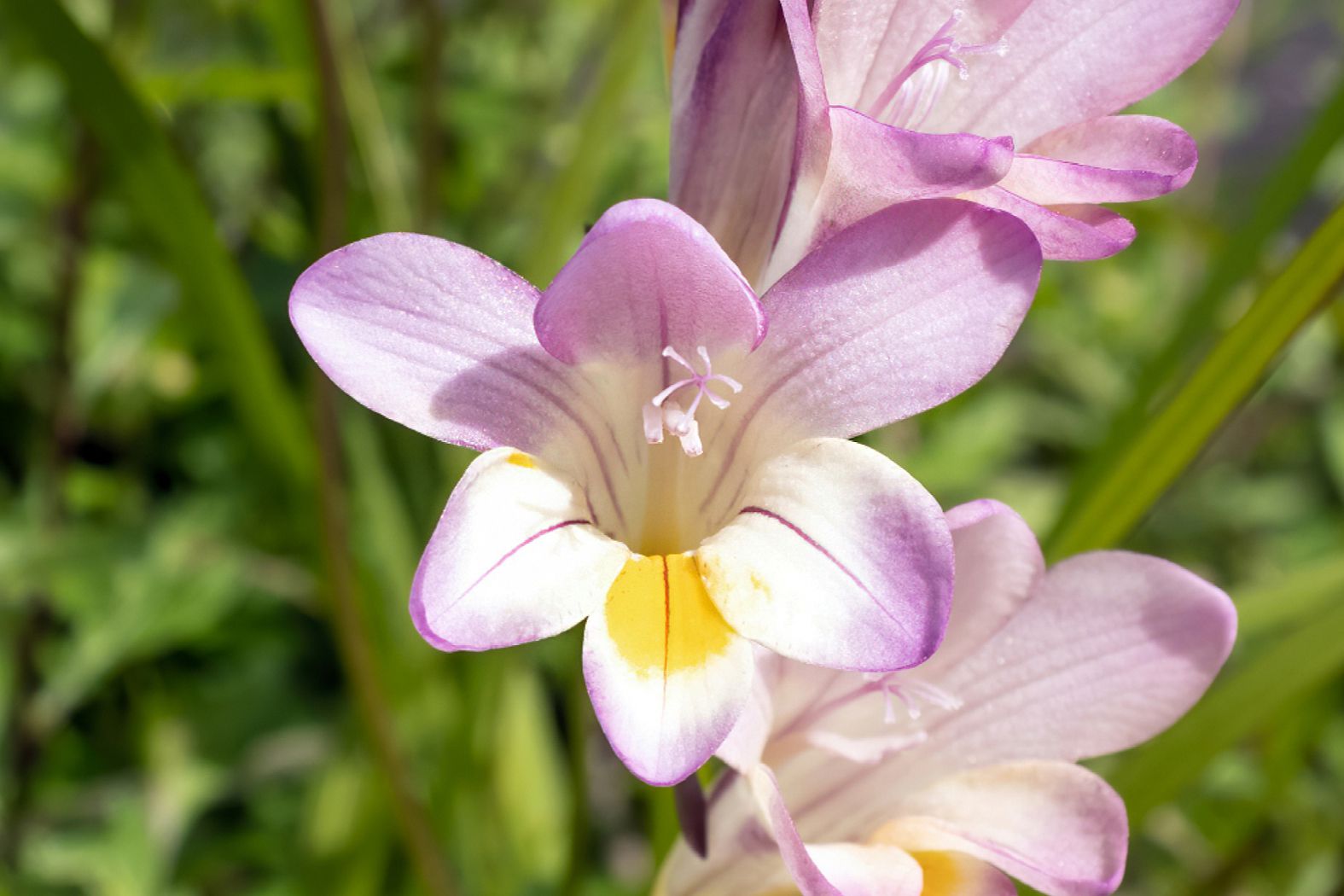
Freesias are beautiful and fragrant flowering plants that have captivated the hearts of gardeners and flower enthusiasts for centuries. With their delicate petals and enchanting fragrance, freesias have become a popular choice for both indoor and outdoor gardens alike. But there is more to these mesmerizing flowers than meets the eye. In this article, we will uncover 15 fascinating facts about freesias that will surely pique your interest and deepen your appreciation for these charming blooms. From their origins in South Africa to their various colors and meanings, you’ll discover the hidden wonders of freesias and gain a newfound admiration for these stunning plants. So, let’s dive into the world of freesias and unravel their secrets.
Key Takeaways:
- Freesia, native to South Africa, symbolizes friendship and love with its vibrant colors and enchanting fragrance. It’s a popular choice for weddings and springtime floral arrangements.
- With its delicate petals and citrusy scent, freesia is not only a beautiful flower but also holds cultural significance in various traditions around the world.
The Origin of Freesia
Freesia is a flowering plant that is native to South Africa. It was first discovered by a German botanist named Christian P. Ecklon in the 19th century. The plant was named after Friedrich Heinrich Theodor Freese, a German physician and botanist who was a close friend of Ecklon.
The Fragrance of Freesia
One of the most distinctive characteristics of freesia is its pleasant fragrance. The flowers are known for their sweet and citrusy scent, which can fill an entire room. This fragrance has made freesia a popular choice for perfumes and scented candles.
Variety of Colors
Freesia flowers come in a wide range of colors, including white, yellow, pink, purple, and red. Each color carries its own symbolism, with white symbolizing purity, yellow representing friendship, pink symbolizing romance, purple representing royalty, and red symbolizing love and passion.
The Symbolism of Freesia
Freesia is often associated with innocence, thoughtfulness, and trust. It is commonly used in floral arrangements and bouquets to convey heartfelt emotions and messages of affection. Gifting freesia is a way to show love, appreciation, or to offer condolences.
Perfect for Springtime
Freesia blooms in the spring, making it a quintessential flower for this season. Its vibrant colors and delicate petals bring a sense of freshness and renewal after the cold winter months. Many people associate freesia with the arrival of spring and the awakening of nature.
The Meaning of the Name
The name “freesia” is derived from the name of the German botanist Friedrich Heinrich Theodor Freese, in whose honor it was named. However, it is interesting to note that the spelling was changed slightly to “freesia” to honor Ecklon and his contribution to the discovery of the plant.
Freesia as a Cut Flower
Freesia is a popular choice for cut flowers due to its long vase life and enchanting fragrance. The flowers can last up to two weeks when properly cared for, and their aromatic scent can add a touch of elegance to any room or floral arrangement.
The Cultural Significance
Freesia plays a significant role in various cultures around the world. In Victorian England, freesia was often given as a symbol of trust and friendship. In some African cultures, freesia is believed to bring good luck and is used in traditional ceremonies and rituals.
Freesia in Art and Literature
Freesia has been a popular subject in art and literature. Its delicate and elegant appearance has inspired many artists and writers to depict freesia in paintings, poems, and other forms of creative expression. It is often associated with beauty, grace, and elegance.
Symbol of Winter Solstice
In some cultures, freesia is considered a symbol of the winter solstice. It is believed to represent the rebirth of the sun and the beginning of longer days after the shortest day of the year. Freesia flowers are often used in festive decorations during this time.
Freesia’s Medicinal Properties
Aside from its beauty and fragrance, freesia also possesses medicinal properties. Some studies suggest that freesia extracts may have anti-inflammatory and antioxidant effects. In traditional medicine, freesia has been used to treat various ailments such as coughs and digestive disorders.
Popular Wedding Flower
Freesia is a beloved choice for wedding flowers due to its delicate appearance and romantic symbolism. It is often used in bridal bouquets, centerpieces, and floral decorations for its elegant beauty and pleasant fragrance that adds a touch of sophistication to the occasion.
Freesia’s Botanical Classification
Freesia belongs to the family Iridaceae and the genus Freesia. It is closely related to other popular flowers such as iris and gladiolus. Freesia plants are bulbous perennials that require well-draining soil and plenty of sunlight to thrive.
Symbol of Friendship
In the language of flowers, freesia is often associated with friendship and loyalty. Giving someone a bouquet of freesia flowers can be a beautiful way to express gratitude for their companionship and to celebrate a lasting friendship.
Freesia’s Global Cultivation
Freesia is cultivated in various parts of the world, including South Africa, California, and the Netherlands. These regions offer the ideal climate and growing conditions for freesia plants to bloom and thrive. The global demand for freesia as both a cut flower and potted plant continues to grow.
These 15 fascinating facts about freesia provide a glimpse into the beauty, symbolism, and cultural significance of this remarkable flower. From its origins in South Africa to its popularity as a wedding flower, freesia captivates hearts with its delicate petals and captivating fragrance. Whether gifted as a token of friendship or used to adorn a special occasion, freesia brings joy and elegance wherever it blooms.
Conclusion
In conclusion, freesias are truly fascinating flowers that capture our attention with their beauty and fragrance. From their origins in South Africa to their popularity as decorative blooms, freesias have enchanted gardeners and flower enthusiasts around the world.Their vibrant colors and delicate petals make them a popular choice for bouquets and floral arrangements, while their sweet fragrance adds a touch of elegance to any space. With proper care and attention, these stunning flowers can thrive in gardens and in containers, bringing joy and beauty to our lives.Whether you’re a seasoned gardener or just starting out, adding freesias to your collection is sure to enhance the visual appeal and aromatic ambiance of your surroundings. Their unique growth habits, adaptive nature, and interesting facts make them a worthy addition for any plant enthusiast.So, the next time you come across freesias, take a moment to appreciate their charm and the fascinating stories they hold. It’s truly amazing how these small flowers can bring so much joy and wonder to our lives.
FAQs
1. How long do freesias bloom?
Freesias typically bloom for about 4 to 6 weeks during the spring and summer months.
2. Are freesias easy to grow?
Yes, freesias are relatively easy to grow, especially in well-drained soil and full sunlight. They are also a popular choice for container gardening.
3. Do freesias have a fragrance?
Yes, freesias have a sweet and pleasant fragrance that can fill the air with their delightful scent.
4. Can freesias be grown indoors?
Yes, freesias can be grown indoors in containers, as long as they receive adequate sunlight and proper care.
5. How do I store freesia bulbs?
Freesia bulbs should be stored in a cool and dry place during the dormant season, and can be replanted when the time is right for their growth cycle.
6. Are freesias susceptible to any diseases or pests?
Freesias can be vulnerable to certain diseases and pests, such as fusarium wilt and aphids. Proper care, regular inspection, and appropriate pest control measures can help prevent these issues.
7. Can freesias be used in floral arrangements?
Yes, freesias are popular choices for floral arrangements and bouquets due to their vibrant colors and delightful fragrance.
8. Are freesias toxic to pets?
Yes, freesias can be toxic to cats and dogs if ingested. It is important to keep them out of reach of pets to avoid any potential harm.
Freesia's alluring qualities captivate flower enthusiasts worldwide. Delightful fragrances and vibrant hues make freesias perfect for any occasion. Symbolizing friendship, these blooms bring joy to gardens and bouquets alike. Botanical classification and global cultivation further highlight freesia's fascinating nature. Explore more astounding freesia facts, and find the ideal perfume type to suit your unique style. Immerse yourself in the enchanting world of freesias!
Was this page helpful?
Our commitment to delivering trustworthy and engaging content is at the heart of what we do. Each fact on our site is contributed by real users like you, bringing a wealth of diverse insights and information. To ensure the highest standards of accuracy and reliability, our dedicated editors meticulously review each submission. This process guarantees that the facts we share are not only fascinating but also credible. Trust in our commitment to quality and authenticity as you explore and learn with us.


